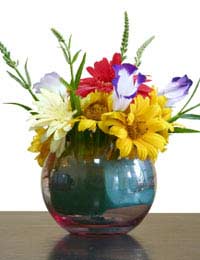Ikebana: Traditional Japanese Flower Arranging

Ikebana is a traditional Japanese art of flower arrangement that has been practiced for over 600 years. However, Ikebana is much more than just decorative. Every arrangement produced in this way is done so with regard for the colour combinations used, the natural shapes and lines of the "living" elements and the meaning of the entire composition.
Many amateur and professional florists remain unaware of the complexities of Ikebana flower arranging, so below are some basic answers to frequently asked questions about this art form.
What is Ikebana?
Ikebana is a traditional Japanese art form that uses living elements such as flowers, branches, leaves and grass as the materials to create a harmonious and often spiritual or philosophical arrangement.What is the History of Ikebana?
Ikebana began in Japan over 600 years ago and it is thought that it was originally a means of offering flowers to the spirits of the dead as in the Buddhist tradition. It was not until the 15th century that this art diverged from its religious origins. Throughout history many different schools of Ikebana evolved, including the Ikenobo, Koryu, Enshu, Ohara and Moribana. The three most predominant modern schools include Ikenobo, Ohara and Sogetsu.How is Ikebana Different from Other Forms of Flower Arrangement?
Ikebana is more than just a way or organising flowers to create an aesthetically pleasing arrangement. This art form usually has an underlying spiritual or philosophical basis to each arrangement, and indeed each aspect of the arrangement is usually invested with meaning.Usually Ikebana arrangements are asymmetrical and very often the empty space within them is just as important as the other materials. Indeed, even the container used for the arrangement and the setting of the arrangement are important in Ikebana.
Is Ikebana a Popular Hobby?
Around the world both men and women practice Ikebana, but it is more than a hobby for many. Ikebana is a profession for many, including those who teach the art to others.What Kind of Materials are Needed for Ikebana?
The materials used in Ikebana arrangements often differ according to the purpose of the arrangement. For example, peach, pine, weeping willow and winterberry area all materials used in Ikebana arrangements for celebratory or auspicious occasions. The occasions often take the form of national holidays or special festivals. Most Ikebana arrangements contain some combination of flowers, branches, leaves and/or grass as well as a bamboo, glass or ceramic container.
Where Can I Learn More About Ikebana?
A variety of books and websites exist which discuss and offer step-by-step instructions on Ikebana. Florists trained in Ikebana may offer lessons in your local area, or Japanese cultural or community centres may offer classes. Night classes may also be given in this art and many workshops and even holidays devoted to Ikebana are available.The Ikebana International London branch will also be able to offer more information on Ikebana. The London School of Ikebana and the Royal Horticulture Society (www.rhs.org.uk) will also be able to provide further information on this topic.


Re: Flower Arranging: Colours and Meanings
Kak esehiko sminor k112 floristryexpert.co.uk
Re: Using Floral Foam
Hi im making wreaths and centre pieces using wet foam...my problem is that the foam still drips when I've done my arrangement...is it best to…
Re: Create Longer Lasting Floral Displays
Hi All! Do Alstroemerias last in an oasis arrangement? Please advise. Many thanks and sunny greetings Kris
Re: Create Longer Lasting Floral Displays
Hi I am doing an underwater display with silk red roses covering all roses with the water adding wax chystals on the…
Re: Create Longer Lasting Floral Displays
How many chrysants do I need for a DAD tribute when purchasing 20 stems per bunch. Thanks Treez
Re: Create Longer Lasting Floral Displays
I was wondering if I could make my arrangement with floral foam self watering by adding cotton string to a reservoir…
Re: Create Longer Lasting Floral Displays
Hi I am making son and brother funeral flowers using chrysanthemums the funeral is on a Friday will it be OK to make…
Re: Create Longer Lasting Floral Displays
I have heard that England was going to bane oasis and had a new black oasis that was more environment safe. Do you…
Re: Create Longer Lasting Floral Displays
I heard there is new oasis that's black and better for the environment. Can't seem to find it. Can you help?
Re: Creating a Victorian Posy
Hi, carrying out a little research, on Posies, due to the book I am writing concerning a Victorian Gent of the 1800's. Yes he had…